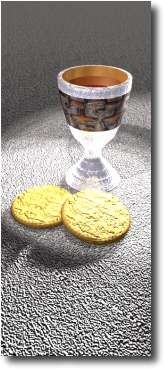 The Solemnity of the Most Holy Body and Blood of Christ or Corpus Christi is celebrated on the Thursday following Trinity Sunday although it is now transferred to the following Sunday. The feast celebrates the Real Presence of Jesus Christ under the appearance of bread and wine in the Blessed Sacrament.
The Solemnity of the Most Holy Body and Blood of Christ or Corpus Christi is celebrated on the Thursday following Trinity Sunday although it is now transferred to the following Sunday. The feast celebrates the Real Presence of Jesus Christ under the appearance of bread and wine in the Blessed Sacrament.
The feast came about following a vision of Juliana of Liège, an Augustinian nun that she received in 1209. She saw a gleaming disc with a dark spot on it. This, she was told, represented the lack of a feast devoted to the Eucharist in the annual cycle. At her urging and that of her spiritual advisor, John of Lausanne, the feast was introduced in the diocese of Liège for the first time in 1246. In 1264, Pope Urban IV, who had been the archdeacon at Liège, extended the feast to the whole Church.
The text of the Mass and the Divine Office are said to be the work of St. Thomas Aquinas, possibly at the request of Pope Urban IV. In these he explores three aspects of the Eucharist relating it to the past, the present and the future – a commemoration of Christ’s Passion and Sacrifice, as sacrament of union with Christ, and the pledge of the glory to come. The three year cycle of readings also reflect on different aspects of the Eucharist: year A on the Real Presence of Jesus Christ (Deuteronomy, 8: 2-3, 14-16, 1 Corinthians 10: 16-17, John 6: 51-58), year B on the Sacrifice of the New Covenant (Exodus 24: 3-8, Hebrews 9: 11-15, Mark 14: 12-16, 22-26), and year C on Christ nourishing the Church in the Eucharist (Genesis 14: 18-20, 1 Corinthians 11: 23-26, Luke 9: 11-17).
The most significant difference in the Mass, apart from the sequence that comes before the Gospel Acclamation (thurifer beware) is the Procession of the Blessed Sacrament that comes at its end. Instead of the final blessing and dismissal the Blessed Sacrament is exposed in the monstrance on the altar and incensed. Then, led by the processional cross, acolytes, other altar servers and clergy and immediately preceded by two thurifers, the Blessed Sacrament is solemnly processed. The procession usually concludes with Benediction.